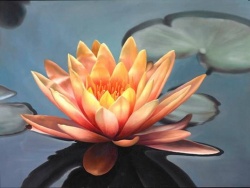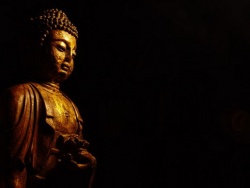Eye-consciousness
There are a lot of consciousnesses described in Buddhist meditation texts.
The first time I started reading about them, my eyes glazed over and I started thinking about lunch. Looking back, I have to wonder which consciousness was on top then… probably body consciousness.
When the Suttas mention “sensuality”, they might be referring to sex but it could also mean a more generalized term that encompasses all senses.
When you feel a pain in your foot, that’s foot consciousness, or more broadly body consciousness. Your attention is on your foot… you are conscious of the feeling in the foot. Are you the foot? No.
Are you the pain? No. You are aware of the pain in the foot. The distinction is necessary when you are exploring this subtle level of being.
There seems to be an “Aha!” moment, or a moment of Zen, where the teaching goes suddenly from the knowing to the doing. The trick is to be aware of it in the moment.
Remembering a time in the past and saying “I saw the Eiffel Tower” is not eye consciousness.
It’s mind consciousness, because you are accessing memory which is in the mind, and picturing it again within the mind.
The five physical senses, though translated in the moment by the mind, have to be experienced in the moment for understanding to occur.
As a lay person myself with a daily meditation practice, I’ve had a few Zen moments. After experiencing eye consciousness myself, I experimented with the phenomenon.
Below are exercises that might help stimulate the subtle realization of eye consciousness. While I am not a meditation master, the Buddha encouraged everyone to “live life as an experiment” so I offer my findings here.
To begin, meditate until you have reached a relatively quiet mental state. Tranquil Wisdom is my favorite, but everyone’s different. Use the method that works best for you to quiet your inner voice and stories so that you can concentrate.
If any of these exercises begin to give you a headache, stop immediately.
It took me several days to build up to a half hour for each of these exercises, and each builds on the one before. Don't rush it.
Exercise 1: Seeing the Snow
Once you have reached a calm mental state, note the condition of your sight- not what you see, but how you perceive it.
Start with your eyes closed. You may see shifting lights, patterns or a TV “snow” effect. Open your eyes and look at a dark part of your surroundings. Note that the patterns tend to be the same when your eyes are open or closed.
Try different colors and levels of darkness and light and compare it to what you see when your eyes are closed.
This is because the mind is always attempting to interpret the information it receives from the visual cortex. Study this phenomenon, periodically opening and closing the eyes and observing the correlation between what the mind produces and what is actually there.
Exercise 2: Invisible Ball
For this exercise, you’ll need a simple, round, fist-sized ball of any color, so long as it does not have a pattern.
Set it about three feet in front of you and, after achieving a relatively tranquil mental state, focus your eyes directly on the ball. Do not move your eyes from the ball for any reason, but blink if you need to.
You may feel an intense desire to look away, even for a second or just an inch away, but really try not to or the exercise takes much longer.
After a while, you will begin to see visual distortions on and around the ball.
Do not avert your eyes, but go ahead and close them for a few seconds if your eyes get tired.
Simply observe the visual phenomenon and attempt to rouse the healthy doubt of how you can perceive so much (or so little) that is not there.
Exercise 3: Observing the Peripheral
As the phenomenon intensifies, your vision will settle. Notice how while your eyes remain focused on the center point of the ball you can direct your attention to other parts of your vision.
You can’t see any more than you ordinarily can out of the corners of your eyes, but your attention is settled on an area, for example, on the far right hand side of your field of vision.
Now ask yourself the question: What part of me is studying the peripheral?
If the body is focusing on the ball in the center of the vision field, then where is the direction coming from to look elsewhere without moving the eyes?
There is an additional layer of awareness here. Try to experience it in the moment.
If there are any classic meditations that involve the exercises I've described above or something similar, I'd be very interested to hear about them. Please email me or comment below if you have anything to add, especially any personal Zen moment about the nature of the eyes.
Eye consciousness
eye-consciousness

